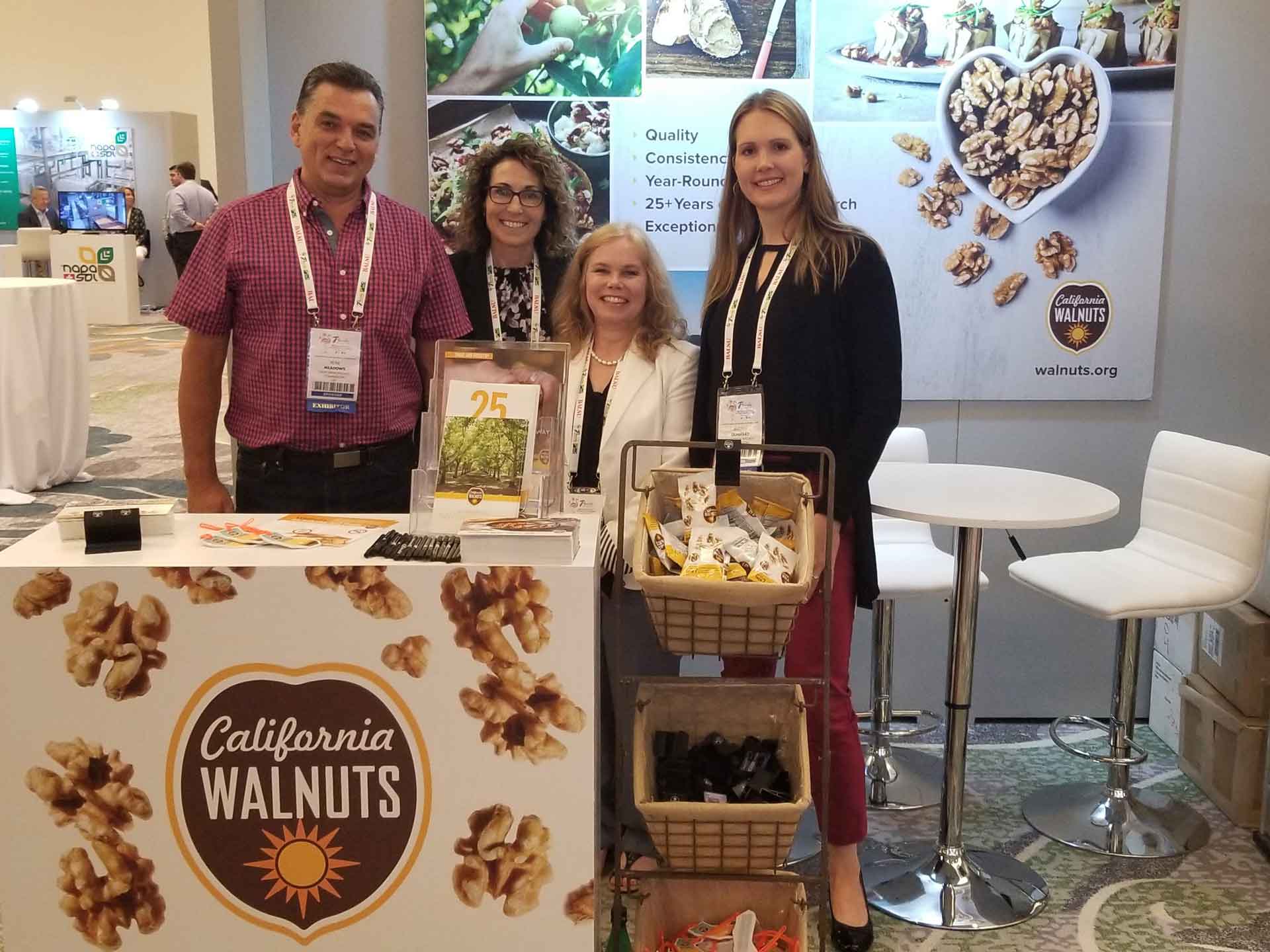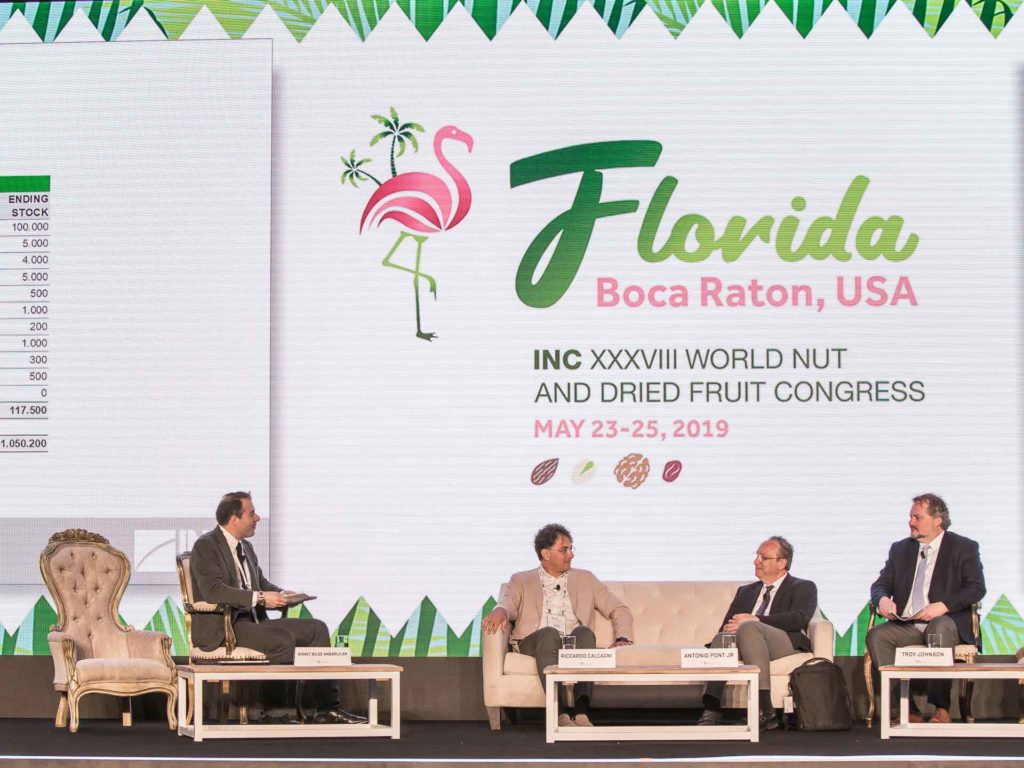
More than 60 countries were represented at this year’s World Nut and Dried Fruit Congress, which was held in Boca Raton, Florida. Nearly 1,300 people attended, many of them presidents and CEOs from the world’s leading nut and dried fruit companies and organizations.
The Congress, or INC (International Nut and Dried Fruit Council), as it is affectionately called, is the largest international gathering of its kind. It’s an annual event for leaders in the industry—big marketers, customers and producers—to network, search out opportunities, and enjoy relaxing social activities with like-minded people.
At these congresses, attendees receive crop forecasts, updates on industry statistics, as well as updates on marketing and consumer demand.
Hazelnuts
Troy Johnson, Managing Director of Laurel Foods, has been a regular attendee and contributor at INC. “My first INC was Barcelona in 2001 and I’ve been to everyone one since with the exception of South Africa in 2002. I’ve also participated in many of the hazelnut presentations and round table discussions,” he said.
This year was no exception. Troy served as a panelist on the INC Hazelnut Round Table, which was chaired by Ahmet Bilge Anbarlilar, of Turkey. The other panelists were Antonio Pont Jr, of Spain and Riccardo Calgagni, of Italy. Around 100 people were in the audience.
Hazelnut Supply
Oregon growers supply 99-percent of domestic hazelnuts, but currently only four-to-seven percent of the world supply. Turkey is a strong first in global production, with a 2019/2020 crop prediction of 770,000 metric tons. Italy ranks second, with a prediction of 90,000 metric tons. The U.S. is optimistic, predicting a possible 2019/2020 crop of 43,000 metric tons, which would inch us ahead of Azerbaijan, with their 42,000 metric-ton prediction, and several tons ahead of the country of Georgia, with a predicted 38,000 metric tons (one metric ton equals 1.10231131 U.S.—or short tons).
In 2017, the U.S. hazelnut crop was 32,000 tons, according to Polly Owen of the Hazelnut Industry Office. But crop numbers are tricky, and come in nearly a year after harvest. “It looks to be 52,000 tons in 2018,” Polly said, adding that the numbers are never a sure thing until after the June reports are in, which isn’t until mid-July (after this article published). “We truly do not know what 2019 will be.
“The world supply is tough since we are never sure of numbers from some of the developing countries. Turkey is easily the largest, followed by Italy, and for years the number three was either Spain or USA. However, production in Azerbaijan and Georgia is reported at about the same as Italy and growing. In the coming years we could rival Italy as well. For now we are likely number five—ahead of Spain,” Polly said.
At the INC Hazelnut Round Table, Troy said of the 2018 U.S. crop, “We had a nut set that was absolutely fantastic.We thought we’d have our best crop ever. Turns out, we had a very hot summer—took its toll on the size of the nuts. Still wound up with the second largest crop ever.”
Troy mentioned Oregon growers’ 3,500 new double-density-planted acres that are coming on strong. (After 10-11 years, every other tree in each row is removed to leave the classic 20-foot-by-20-foot spacing). He also reported that the older hazelnut tree varieties, which are not Eastern Filbert Blight resistant, have taken a hard hit, with only about a third of the nut set they had before they were blighted.
“The Chinese market has always been our biggest market,” Troy said. “But because of the tariff situation, our grower price was significantly lower.” Grower field price for the 2018 crop was $0.62 per pound, which, Troy noted, was probably well below a break-even point—perhaps by as much as 25-percent. “So,” he said, “the price does need to be higher.” Historically, hazelnuts have been a profitable crop.
Chinese buyers are mainly interested in large hazelnuts in the shell, and process the nuts themselves. Chinese consumers shell and eat hazelnuts as a healthy snack food, much the same way American consumers shell and snack on pistachios.
Even with the trade war, Chinese buyers still came through, although the U.S. didn’t have as many big, in-shell nuts to offer from last year’s crop. “Anything remaining is shelling stock,” Troy said. “Everybody’s about out. Quality’s been exceptional.”
Troy also gave a report on hazelnut production in Chile: They continue to plant an additional new 1,000 hectares each year (one hectare equals 2.471 acres), and are up to about 20,000 hectares total. Chile is growing newer blight-resistant varieties from Oregon State University—Yamhill, McDonald and Jefferson. Troy noted that growers have to pay a royalty on those varieties. He also mentioned Polly O, which is another new Oregon State University (OSU) bred variety, and named after Polly Owen: “It has a higher kernel yield. We expect those to be more for the industrial sector.” Troy said.

Hazelnut Demand
Ahmet, of Turkey, said developing countries have an aging population. Those people are pickier about what they eat, “which is good for hazelnuts,” he said. “I see a bright future.”
Riccardo, of Italy, noted that not only is there Nutella—a chocolate hazelnut spread made in Mexico by Ferrero—but other hazelnut butters now to add to bread for a healthy breakfast. Hazelnuts as a snack in China appeals to Chinese taste, he said, “and the coffee taste behind the hazelnut is really appreciated in Europe.”
Antonio, of Spain said, “When the economy of a country grows, consumption of chocolate increases, which affects hazelnuts.” He looks not only for the hazelnut confection market to expand, but also an expanding market for hazelnut milk. “Like almond milk. I think this is going to be a new, big trend.”
Troy believes the hazelnut industry is “absolutely growing.” He’s excited about the new launch of hazelnut M&M candy made with hazelnut paste. He said research and development people are looking for other new alternatives for hazelnut use. He mentioned the current plant-based diet trend. “Almonds have always been in that category. Nearly every new product has an almond in it, and I think in the future we’re going to see more and more new products with hazelnuts.”
Troy also brought up the hazelnut’s sustainability: “We have a great story when it comes to sustainability. We take far less water to grow than many of the other nut commodities.”
Besides confections, nut milk and nut butters, Troy believes the hazelnut industry will see growth in culinary demand, in nut oils and in research-and-development ingredients.
Turkey is also optimistic about hazelnuts. Ahmet said that 10-15 years ago, the industry questioned whether the world could consume all the hazelnuts produced, “but in recent years, we are almost sure we don’t have a demand problem.”
In Italy, some growers are replacing traditional crops, such as peaches, pears, oranges and olives with hazelnut orchards. “Growers like to diversify their risk and the growers like a sustainable crop,” Riccardo said.
There are over 81,000 acres of hazelnuts planted in the Willamette Valley. More than half of those acres are new plantings of OSU blight-resistant varieties. These hazelnut orchards are replacing crops such as grass seed and nursery stock. “What’s happening in Oregon is transition from ryegrass to hazelnuts,” Troy said in an interview a month after INC. “Oregon has the greatest production of pounds per acre in the world (of hazelnuts).” He’s watching as 20, 50 and 100-acre plots of grass-seed fields at a time are being replaced with hazelnuts.
Troy notes that Oregon hazelnut trees are typically alternate bearing. “We think mostly that has to do with weather events. I don’t think we’ve ever had two up years in a row.” But, he added, “We’ve had two down years in a row.”
Regardless, Troy believes the hazelnut industry will continue to grow. “It’s absolutely shocking to drive by and see all these little trees. Go on Google Earth and you can see the outlines of the hazelnut orchards.”
Walnuts
In 2018, INC was held in Spain. Since the California Walnut Board has a marketing program in Spain, they sent representatives. In 2016, INC was held in San Diego, California. “That’s practically in our backyard,” said Jennifer Williams, Marketing Director at the California Walnut Board, located in Folsom. The attendees took tours that year of raisin-grape vineyards, prune-plum orchards, and almond and walnut orchards, Jennifer said. Then they all sat down to dinner together with people from all over the world.
Michelle McNeil Connelly, executive director & CEO at the California Walnut Board & Commission, attended this year’s INC in Florida. She said the Walnut Round Table discussion was a highlight for her. The walnut panel was chaired by John Aguiar of Mariani Nut Company, USA. The roundtable also featured panelists Gary Ford of Diamond Foods, USA, Maria G. Kraus, European Union (EU) Representative for California Walnut Commission, Germany, and Gunjan Jain of VKC Nuts, India. The panelists talked about the dynamic and evolving consumer walnut market, giving perspectives on who the typical consumer is and what influences them. Panelists also looked at food trends which are driving innovation and categories for future walnut growth.
More than 99-percent of the U.S. grown walnuts come from the Central Valley in California, supplying two-thirds of the world’s walnut trade.
“The global walnut outlook remains strong despite the tariffs and global economic challenges of the last year,” Michelle said, “with gains in production expected not only from California but other producers including Chile and China.”















